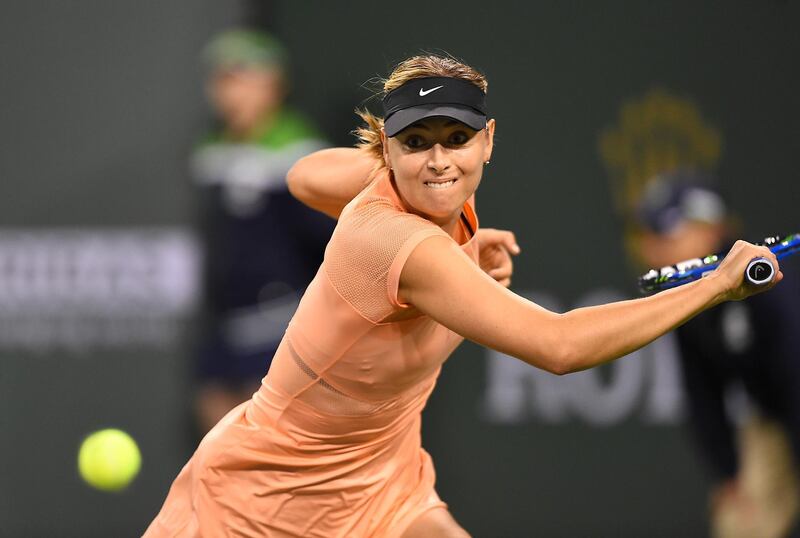It was one year ago when Maria Sharapova made her highly-anticipated return to professional tennis after a 15-month doping suspension.
The Russian former world No 1 was handed a wildcard by the Stuttgart Open – a tournament she has won three times and whose title sponsor, Porsche, is also one of Sharapova's biggest endorsers.
Sharapova required the wildcard because, as the rules state, a player returning from a doping suspension loses their ranking. It was an encouraging return, reaching the semi-finals before going down to then world No 19 Kristina Mladenovic.
Yet here we are one year later and Sharapova once again needs a wildcard to compete in Stuttgart.
So what has happened in the past 12 months that means Sharapova, a winner of five grand slam titles who spent 21 weeks atop the world rankings, is still not back near the top of women’s tennis? And will she ever get back to where she once was?
___________
Read more:
Nadal capable of title sweep: ATP's European clay court swing talking points
Get used to more speeches - Naomi Osaka has all the attributes to reach the very top
Juan Martin del Potro can be regarded as an elite star again alongside Federer and Co
___________
To recap, Sharapova has played 12 tournaments since her return. She has won one title, in Tianjin, China where she beat a player ranked outside the top 100 in the final. Her other best efforts were two semi-final appearances, in Stuttgart last year and in Shenzhen at the start of this season.
Her performances so far have led to a world ranking of No 41. When Sharapova was suspended in March 2016, she was ranked No 7.
Some of her struggles can be attributed to fitness issues. A thigh injury saw her withdraw from the second round in Rome last May which caused her to miss qualifying for Wimbledon. Then an arm injury in August meant Sharapova missed tournaments in Stanford, Toronto and Cincinnati.
This season has also been affected by the arm injury, with Sharapova struggling to discover her best form. The 31-year-old Russian has won just five matches in four tournaments, including successive first round defeats in her past two outings, although her most recent loss was to eventual Indian Wells champion Naomi Osaka.
There have been a few bright spots, though, none more so than the first round victory over then world No 2 Simona Halep at the US Open.
But while her lengthy absence and subsequent injuries can be partly to blame, there’s no escaping the fact that Sharapova’s return has so far failed to deliver.
In a recent interview with CNN, Sharapova said she “didn't put any expectations on myself coming back after the suspension”. That may be so, but for an athlete famous for her steely determination and fierce competitiveness, she is unlikely to be too satisfied with her progress.
The concern for Sharapova is whether she can ever recapture her former glories. Even though she was away for a relatively short space of time, it feels like the game has moved on without her.
A glance at the WTA world rankings give a clear indication that tennis is a young woman’s game. There are only two women in the top 20, Venus Williams and Angelique Kerber, who are 30 or older, and only four in the top 40.
Sharapova does not possess the sort of power that can get her out of trouble, nor the relentless endurance and speed that can keep her in points, while her serve can at times be unreliable.
Instead the Russian possesses a solid all-round game supported by a sharp mind and never-say-die attitude. It is that mental fortitude that served her so well throughout her career and will need to again if she is to return to the upper echelons. Whether that will be enough when competing against younger, fitter women remains to be seen.
Sharapova still has crowd-pulling power, but she is not the same huge draw she once was. Women’s tennis is in safe hands with the current generation and unless Sharapova makes her move back toward the top soon, she is in danger of it never happening.
Perhaps the European clay courts will kickstart her season. Clay had been Sharapova’s weaker surface earlier in her career, but she has won eight of her 11 clay court titles in the past eight years, including two French Open crowns.
Sharapova faces a tough task in her opening round in Stuttgart on Tuesday when she faces world No 7 Caroline Garcia, the 24-year-old Frenchwoman who makes up part of the new generation and who occupies the ranking Sharapova held pre-suspension.
Her current ranking means Sharapova will be constantly at risk of meeting the top players early in tournaments, which unless she starts getting her fair share of wins, will only slow down her ambitions of a return to the top.
Could a win over Garcia provide the boost Sharapova needs? Perhaps, but there still feels a long way to go. However, given Sharapova's unrelenting mindset, she will never stop trying to get there.





